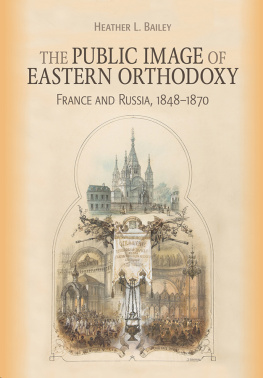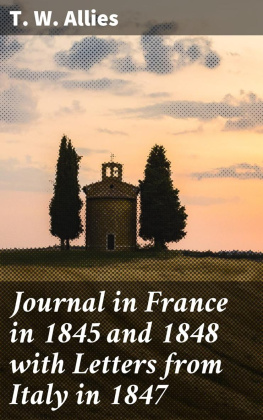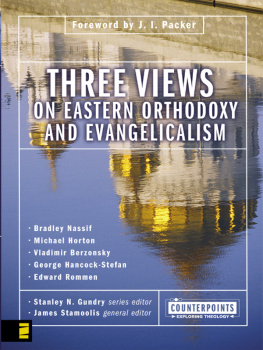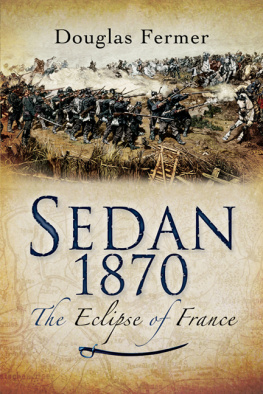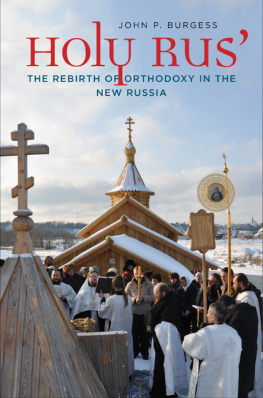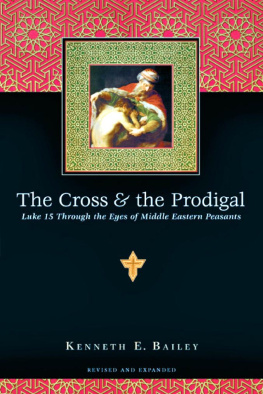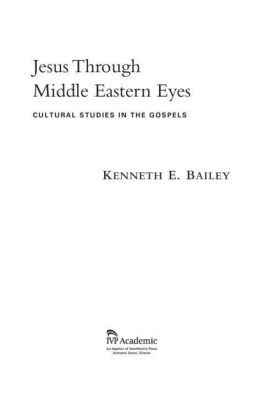Heather L. Bailey - The Public Image of Eastern Orthodoxy: France and Russia, 1848–1870
Here you can read online Heather L. Bailey - The Public Image of Eastern Orthodoxy: France and Russia, 1848–1870 full text of the book (entire story) in english for free. Download pdf and epub, get meaning, cover and reviews about this ebook. year: 2020, publisher: Cornell University Press, genre: Religion. Description of the work, (preface) as well as reviews are available. Best literature library LitArk.com created for fans of good reading and offers a wide selection of genres:
Romance novel
Science fiction
Adventure
Detective
Science
History
Home and family
Prose
Art
Politics
Computer
Non-fiction
Religion
Business
Children
Humor
Choose a favorite category and find really read worthwhile books. Enjoy immersion in the world of imagination, feel the emotions of the characters or learn something new for yourself, make an fascinating discovery.
- Book:The Public Image of Eastern Orthodoxy: France and Russia, 1848–1870
- Author:
- Publisher:Cornell University Press
- Genre:
- Year:2020
- Rating:4 / 5
- Favourites:Add to favourites
- Your mark:
- 80
- 1
- 2
- 3
- 4
- 5
The Public Image of Eastern Orthodoxy: France and Russia, 1848–1870: summary, description and annotation
We offer to read an annotation, description, summary or preface (depends on what the author of the book "The Public Image of Eastern Orthodoxy: France and Russia, 1848–1870" wrote himself). If you haven't found the necessary information about the book — write in the comments, we will try to find it.
The Public Image of Eastern Orthodoxy: France and Russia, 1848–1870 — read online for free the complete book (whole text) full work
Below is the text of the book, divided by pages. System saving the place of the last page read, allows you to conveniently read the book "The Public Image of Eastern Orthodoxy: France and Russia, 1848–1870" online for free, without having to search again every time where you left off. Put a bookmark, and you can go to the page where you finished reading at any time.
Font size:
Interval:
Bookmark:

In loving memory of Jack and Oralee Bailey
I would like to express my gratitude to the many individuals and institutions that have supported me in the process of researching and writing this work.
Financial support from the College of Liberal Arts and the office of the Vice Chancellor for Academic Affairs at the University of Illinois Springfield (UIS) has made this work possible. For their indispensable help with the bibliography and acquisition of materials I thank Jan Adamczyk (International and Area Studies Library), Joseph Lenkart (Manager of the Slavic Reference Service, International and Area Studies Library), and Geoffrey Ross (History, Philosophy, and Newspaper Library) at the University of Illinois Champaign-Urbana, as well as Mary OBrien and Carol Reese in the Interlibrary Loan Department of Brookens Library at UIS. Several individuals answered my questions through SINDBAD, the research information service of the Bibliothque nationale de Franceincluding Cllia Guillemot and Colette Laspalles in the Dpartement droit, conomie, politique; Ingrid Bzard and Sverine Boullay in the Dpartement philosophie, histoire, sciences de lhomme; and Roger Musnik and Mariusz Olczykowski in the Dpartement littrature et art. I thank the archivists at the French Archives nationales and Archives diplomatiques, as well as Vronique Bontemps at the Archives diocsaines de Nantes for their assistance in locating unpublished manuscripts. Hlne and Serge Runge, parishioners at and local experts on St. Alexander Nevsky Cathedral in Paris, met and corresponded with me, supplying me with valuable information on the history of the parish. Alexandre Jevakhoff was kind enough to meet with me and answer questions about the parish library.
I especially thank Tatyana Bakhmetyeva, Nadieszda Kizenko, and Roy Robson for valuable suggestions on how the manuscript could be improved in between its original and final form. Joshua Falconer, Kevin Kain, Paul Ladouceur, and Matt Miller read parts of the manuscript and responded to my queries. Theofanis G. Stavrou offered advice and encouragement at various stages of the project. Other scholars in the field and colleagues in my department, perhaps unbeknownst to them, have helped me develop parts of the manuscript by suggesting bibliography, asking pointed questions, or proposing analytical frameworks. Two colleagues in the Department of History at UIS, David Bertaina and Peter Shapinsky, helped shape specific aspects of my analysis. There are a number of individuals who have made pertinent suggestions, asked insightful questions that helped me conceptually, or offered general encouragement for the project. I would like to thank Charles Arndt, Stephen Batalden, Joel Brady, Eugene Clay, Lucien Frary, Faith Hillis, Scott Kenworthy, Erich Lippmann, Matt Miller, Jennifer Spock, Chrissy Stroop, Paul Valliere, Paul Werth, Christine Worobec, and fellow members of the Association for the Study of Eastern Christian History and Culture for their comments and questions at conferences and by correspondence.
Several individuals helped me obtain otherwise elusive sources: Father Sergei Alekseev, Arkady Avdienko, Kevin Kain, and Nathan Mason. For helping me translate tricky passages or decipher cultural references, I thank Father Sergei and my colleagues at UIS Rosina Neginsky and Larry Shiner. For general encouragement, I thank Father Martin Swanson, rector of St. Basil the Great Orthodox Church in St. Louis, MO.
I am indebted to Amy Farranto, Karen Laun, Sarah Noell, and Carolyn Pouncy for so skillfully guiding me and this manuscript through the publication process from submission to production.
Finally, since the early stages of this project, I have been blessed by the unwavering support and patience of my husband Travis Marshall. It is hard to imagine having completed this project without his willingness to listen and his reminders that at some point, one has to fire the engineers and build something.
A few words about nomenclature, translation, and transliteration are in order. First, regarding usage and spelling of the term tsar, because of the potential links between the spelling czar and anti-Russian sentiment, a subject that turned out to be beyond the scope of this study, when translating from French sources, I have retained whatever spelling (czar, tzar, or tsar) appears in the original. When not quoting, I use the spelling tsar in conformity with accepted standards of transliteration from Russian. In diplomacy, the official title of the ruler of imperial Russia was emperor, not tsar.
A second point of usage concerns the descriptor Greek to refer to the Eastern Orthodox faith or the Russian Church in general. In the nineteenth century, westerners commonly used the descriptors Greek and Russian as synonyms when talking about the Eastern Church. For Roman Catholic publicists, the terms Greek Church ( lglise grecque ) and Russian Church ( lglise russe ) served a polemical purpose, highlighting the Eastern Churchs noncatholicity. They also did not refer to the Eastern Church as Orthodox unless they used the term in italics, as the equivalent of scare quotes, to indicate that the orthodoxy was only purported. Consequently, in this study the modifier Greek usually refers to a religious and not an ethnic group. Context should make the exceptions clear. It should also be noted that in their polemics with Roman Catholics, Orthodox priest-publicists referred to their church as the Russian Church ( lglise de Russie ; lglise russe ) if talking specifically about Russias established church, or as the Eastern Church ( lglise orientale ), Eastern Catholic Church ( lglise catholique orientale ), or Orthodox Catholic Church ( lglise catholique orthodoxe ) when talking about Orthodoxy more generally. Inclusion of the term catholic in the latter two emphasized Orthodoxys claim to being the truly catholic (i.e., universal) church in contrast to the Roman Church.
Third, French polemical works often used the term pope (plural popes ), derived from the Russian pop (plural popy ) and Greek papas , meaning father, to refer to the parish (i.e., secular or white) Orthodox clergy. For French Catholic polemicists, use of pope instead of prtre (priest) was another way to distinguish between Roman Catholicism and Eastern Orthodoxy. Since the French writers were othering when not being derogatory, I have tried not to translate pope(s) when quoting French sources. It should be easy not to confuse pope in these contexts with references to the pope (i.e., the bishop of Rome).
Unless otherwise stated, translations from French and Russian are my own, sometimes refined with the aid of individuals mentioned in the Acknowledgments. I have cited from English translations of French works when they exist. However, in matters with direct bearing on the argument (e.g., discussions of usage or nomenclature) I have not neglected to consult the French originals. I have followed the Library of Congress system of transliteration from Russian, except that I have Anglicized common Russian names and have not used apostrophes for the miagkii znak (soft sign) in the middle of names (hence Vasiliev instead of Vasil'ev , Muraviev instead of Murav'ev , and Kapelmans instead of Kapel'mans ) except when transliterating Russian sources in the notes and bibliography. I have not distinguished between the ye ( e ), yo (), and the yat' () or retained the tverdy znak () at the ends of words.
A Russian church, wherever it may be, is Russia.
Prince Petr Andreevich Viazemsky, 1855
Critics of Russia have long tended to view the Russian Orthodox Church as subordinated to the state and the predominant religion in Russia as a political instrument of autocratic rulers. This model has been applied to tsarist, Soviet, and post-Soviet regimes.
Next pageFont size:
Interval:
Bookmark:
Similar books «The Public Image of Eastern Orthodoxy: France and Russia, 1848–1870»
Look at similar books to The Public Image of Eastern Orthodoxy: France and Russia, 1848–1870. We have selected literature similar in name and meaning in the hope of providing readers with more options to find new, interesting, not yet read works.
Discussion, reviews of the book The Public Image of Eastern Orthodoxy: France and Russia, 1848–1870 and just readers' own opinions. Leave your comments, write what you think about the work, its meaning or the main characters. Specify what exactly you liked and what you didn't like, and why you think so.

